Starting a welding project can feel overwhelming when you see the long list of tools needed. Every welder needs basic tools like a welding helmet, gloves, angle grinder, and clamps to work safely and effectively. Whether you’re a beginner or experienced welder, having the right equipment makes all the difference in your results.
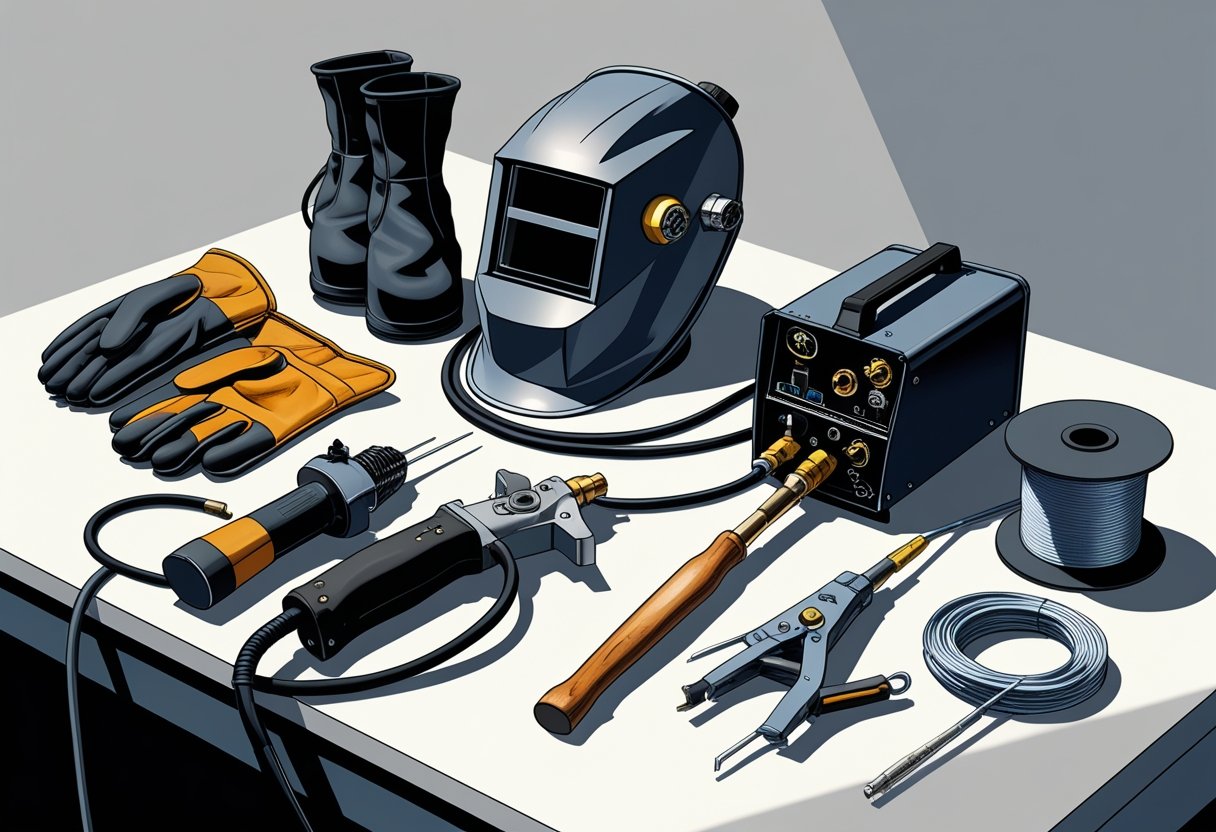
The right welding tools protect you from injury and help create strong, clean welds. Safety gear keeps you protected from sparks and harmful rays. Measuring tools ensure precise cuts and joints.
This guide covers everything from basic safety equipment to advanced technology. You’ll learn which tools are essential for beginners and which ones can improve your skills as you grow. We’ll also explain how to choose quality tools that will last for years.
Key Takeaways
- Essential welding tools include safety gear, cutting equipment, and measuring devices for successful projects
- Proper protective equipment like helmets and gloves prevents serious injuries from heat and sparks
- Advanced tools and technology can improve welding precision and efficiency as skills develop
Essential Welding Tools
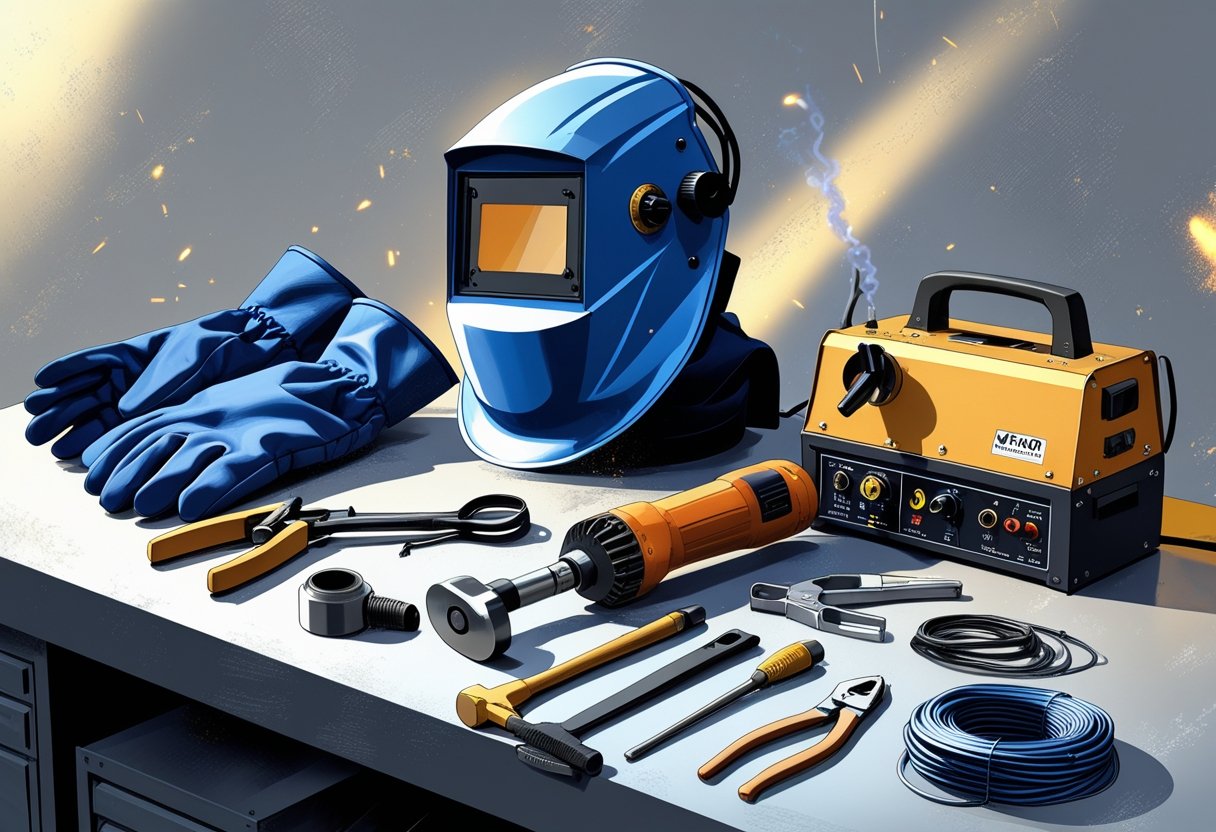
Welding requires specific machines to create heat and join metals, along with consumable materials that form the actual weld joint. Proper cutting equipment and gas control systems complete the basic setup needed for most welding operations.
Welding Machines and Power Sources
The welding machine provides the electrical power needed to create an arc between the electrode and base metal. Stick welders work well for beginners and handle most basic projects with simple controls.
MIG welders feed wire automatically and work faster than stick welding. They need shielding gas to protect the weld from air contamination.
TIG welders offer the most control and create clean, precise welds. They require more skill but produce high-quality results on thin materials.
Power output determines what thickness of metal you can weld. Most home projects need 140-200 amps. Heavy industrial work may require 300+ amps.
Key power source features:
- Adjustable amperage control
- Duty cycle rating (how long it can run continuously)
- Input voltage requirements (110V or 220V)
- Portable vs. stationary design
Welding Electrodes and Wires
Electrodes and filler wires become part of the finished weld joint. Stick electrodes have a flux coating that protects the molten metal and helps the arc stay stable.
E6013 electrodes work well for beginners on clean metal. E7018 electrodes create stronger welds but need dry storage to prevent moisture damage.
MIG wire comes in different diameters and alloys. 0.030″ wire suits thin materials while 0.035″ handles thicker sections better.
TIG filler rods match the base metal composition. ER70S-2 works for most carbon steel projects. Stainless steel and aluminum need specific rod types.
Wire and electrode selection depends on:
- Base metal type and thickness
- Welding position (flat, vertical, overhead)
- Strength requirements
- Indoor vs. outdoor use
Cutting Tools for Welding
Metal preparation requires cutting tools to size materials before welding. Angle grinders with cutting discs slice through most metals quickly and leave smooth edges.
Plasma cutters use an electric arc to cut conductive metals. They work faster than grinders and create less heat distortion on thin materials.
Oxy-fuel torches cut thick steel effectively but require oxygen and fuel gas cylinders. They also work for heating and bending metal.
Band saws and chop saws make straight cuts with minimal waste. They work well for cutting multiple pieces to the same length.
Essential cutting accessories:
- Cutting discs (various thicknesses)
- Clamps and guides for straight cuts
- Safety equipment for sparks and debris
- Measuring tools for accurate sizing
Gas Cylinders and Regulators
Shielding gases protect the weld pool from oxygen and nitrogen in the air. Argon works for TIG welding most metals and creates clean, strong welds.
CO2 costs less than argon but creates more spatter in MIG welding. It works well for thick steel projects where appearance matters less.
Argon/CO2 mixtures balance cost and quality. Common ratios include 75% argon/25% CO2 for general steel welding.
Regulators control gas flow from high-pressure cylinders to the welding torch. They include pressure gauges and flow meters for precise control.
Gas system components:
- Cylinder (various sizes from portable to large shop tanks)
- Regulator with dual gauges
- Gas hose rated for welding
- Flowmeter for accurate gas flow measurement
Personal Protective Equipment for Welders
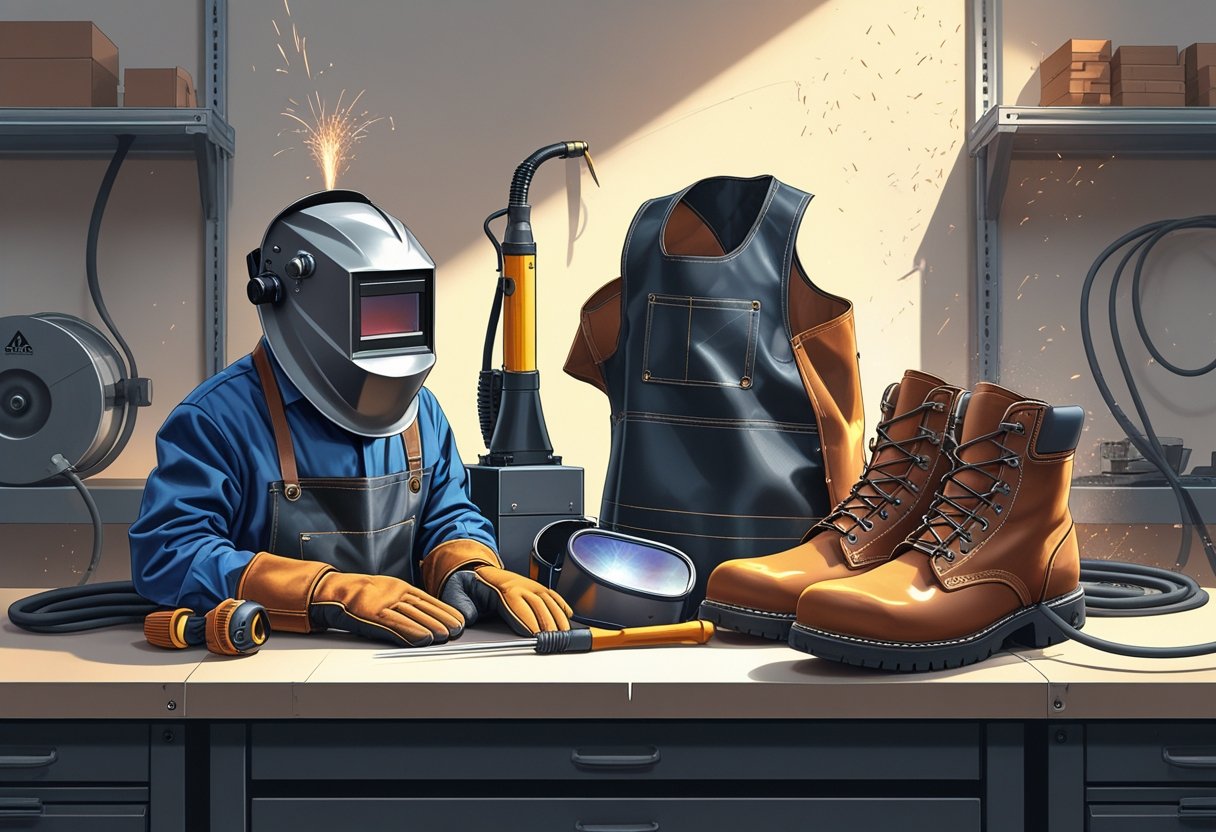
Welders face multiple hazards including UV radiation, intense heat, toxic fumes, and flying sparks. Proper protective equipment shields the eyes, skin, and respiratory system from these dangers.
Welding Helmets and Safety Goggles
Welding helmets protect the face, eyes, and neck from harmful UV radiation and bright welding arcs. Auto-darkening helmets adjust automatically to different light levels, while passive helmets use fixed-shade lenses.
The helmet’s lens shade number determines protection level. Shade 10-13 works for most arc welding processes. Shade 8-10 suits gas welding and cutting.
Safety goggles provide additional eye protection under the helmet. They shield against:
- Flying sparks and debris
- Reflected UV light
- Chemical splashes during prep work
Key helmet features:
- Impact-resistant shell
- Comfortable headgear with adjustable straps
- Large viewing area for better visibility
- Lightweight design to reduce neck strain
Quality helmets meet ANSI Z87.1 safety standards. The lens should cover the entire face opening without gaps.
Gloves and Protective Clothing
Welding gloves protect hands from heat, sparks, and UV radiation. Leather gloves offer the best protection for most welding tasks. TIG welding requires thinner, more flexible gloves for precise control.
Glove materials include:
- Cowhide: Durable and heat-resistant
- Pigskin: Soft and flexible
- Goatskin: Excellent dexterity for TIG work
Protective clothing covers exposed skin from sparks and UV rays. Flame-resistant materials like treated cotton or leather work best. Synthetic fabrics melt and should be avoided.
Essential clothing items:
- Long-sleeved shirts or welding jackets
- Full-length pants without cuffs
- Leather aprons for heavy welding
- Steel-toed boots with ankle protection
Dark-colored clothing absorbs UV radiation better than light colors. All clothing should fit properly without loose ends that could catch sparks.
Respirators and Ventilation Equipment
Respirators protect welders from toxic fumes and particles. The type depends on the welding process and base materials being joined.
Disposable masks filter basic particles but don’t stop gases. Half-face respirators with cartridge filters remove specific contaminants. Powered air-purifying respirators (PAPRs) provide the highest protection level.
Common welding fumes include:
- Manganese from steel welding
- Chromium and nickel from stainless steel
- Zinc from galvanized materials
- Aluminum particles
Ventilation systems remove fumes at the source. Local exhaust ventilation pulls contaminants away from the breathing zone. General ventilation dilutes airborne particles throughout the workspace.
Proper ventilation reduces respirator dependence. However, confined spaces and heavy fume production still require respiratory protection even with good airflow.
Cartridge filters need regular replacement based on usage and contamination levels. Fit testing ensures proper respirator seal around the face.
Welding Accessories and Consumables
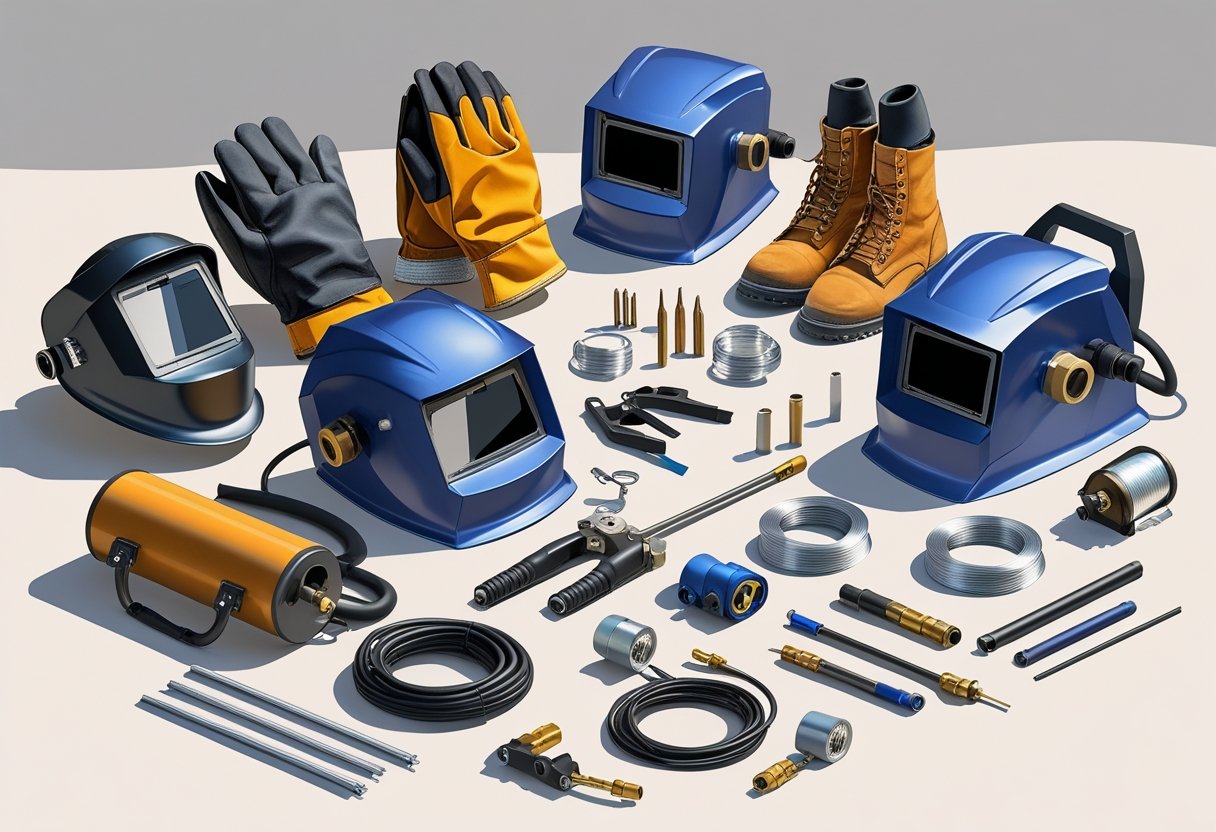
Welding accessories and consumables keep projects running smoothly and ensure clean, precise welds. These tools include positioning equipment, cleaning supplies, and replacement parts that wear out during regular use.
Clamps and Magnets
Welding clamps hold metal pieces in the correct position during welding. C-clamps work well for basic projects and can grip materials up to 6 inches thick. Locking pliers provide quick adjustment and strong grip force.
Welding magnets create temporary joints without mechanical fasteners. Standard magnetic squares hold pieces at 45-degree and 90-degree angles. Heavy-duty magnets can support up to 25 pounds of steel.
Common clamp types:
- C-clamps for general holding
- Locking pliers for quick positioning
- Pipe clamps for round materials
- Corner clamps for precise angles
Magnetic welding holders come in different strengths. Light-duty magnets work for thin sheet metal. Heavy-duty versions handle thick structural steel and provide stronger holding power.
Chipping Hammers and Wire Brushes
Chipping hammers remove slag and spatter from finished welds. The pointed end breaks away thick slag buildup. The chisel end cleans wider areas and smooths rough spots.
Wire brushes clean metal surfaces before and after welding. Stainless steel brushes work on all metals without contamination. Carbon steel brushes cost less but can leave residue on stainless steel.
Brush types and uses:
- Hand brushes for small areas
- Cup brushes for power tools
- End brushes for tight spaces
- Twisted wire brushes for heavy cleaning
Electric chipping hammers speed up slag removal on large projects. They reduce hand fatigue and work faster than manual hammers. Pneumatic versions provide consistent power and last longer.
Nozzles and Contact Tips
Contact tips transfer welding current to the wire in MIG welding. Different tip sizes match specific wire diameters. Tips wear out from heat and electrical arcing during normal use.
Contact tip specifications:
- 0.030″ tips for thin wire
- 0.035″ tips for general welding
- 0.045″ tips for heavy materials
- Copper tips for standard applications
Gas nozzles direct shielding gas around the weld pool. Ceramic nozzles resist heat better than metal versions. Larger nozzles provide better gas coverage but limit access in tight spaces.
Nozzles get clogged with spatter during welding. Anti-spatter spray reduces buildup and makes cleaning easier. Tapered nozzles work better in corners and confined areas than straight designs.
Measuring and Layout Tools for Welding
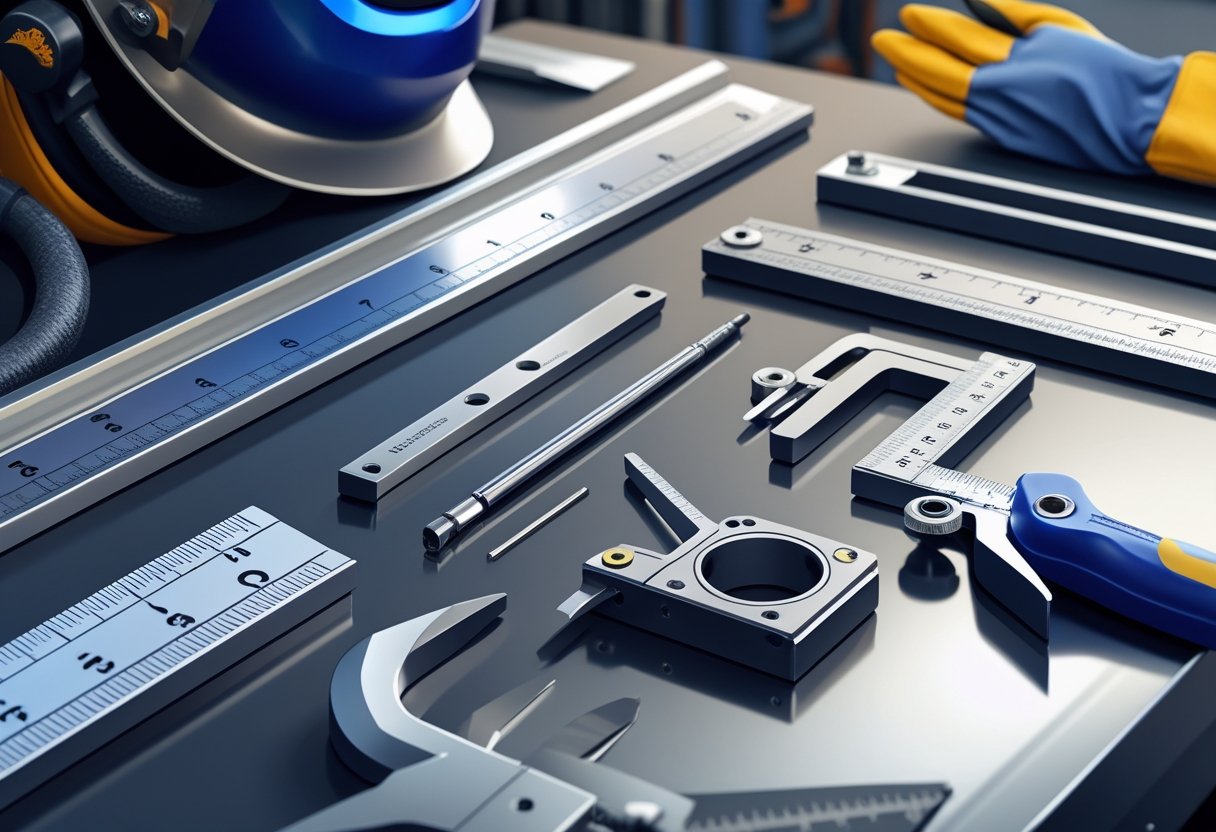
Accurate measurements form the foundation of quality welding work, requiring specialized tools that handle the unique demands of metal fabrication. Professional welders rely on precision instruments for linear measurements, angle verification, and permanent marking on various metal surfaces.
Tape Measures and Rulers
Steel tape measures are essential for most welding projects. They resist heat better than standard tapes and provide measurements up to 25 feet or more.
Rigid steel rulers offer superior accuracy for shorter measurements. Most welders prefer 6-inch, 12-inch, and 24-inch lengths for different tasks.
Folding rules work well in tight spaces where tape measures become awkward. They maintain their shape and provide stable reference points.
Digital calipers measure internal and external dimensions with extreme precision. They read down to 0.01 millimeters or thousandths of an inch. These tools are vital for checking pipe thickness, gap measurements, and small part dimensions.
Pipe measuring tools wrap around cylindrical surfaces to measure circumference accurately. They include integrated scales for marking angles and cuts on pipes.
Angle Finders and Squares
Combination squares check 90-degree and 45-degree angles quickly. They also measure depth and mark parallel lines on metal surfaces.
Speed squares provide fast angle measurements and serve as cutting guides. Their triangular shape makes them ideal for layout work on structural steel.
Digital angle finders display precise angle measurements on LCD screens. They work well for complex angles that traditional squares cannot measure.
Protractors measure and mark specific angles from 0 to 180 degrees. Some models include adjustable arms for transferring angles between pieces.
Framing squares help with large-scale layout work. They ensure perpendicular cuts and joints on bigger fabrication projects.
Marking Tools
Soapstone markers create visible lines that withstand welding heat. They work on dirty or oily surfaces where other markers fail.
Metal scribes scratch permanent lines into metal surfaces. They create precise marks that remain visible throughout the welding process.
Center punches make small indentations to mark hole locations. They prevent drill bits from wandering when starting holes.
Chalk lines mark long, straight lines quickly across large metal sheets. They snap precise reference lines for cutting and welding.
Permanent markers work well on clean metal surfaces for temporary markings. Some varieties resist heat and oil better than others.
Advanced Welding Equipment and Technology
Modern welding technology uses machines and computers to make welding faster and safer. These tools help welders work more precisely while protecting them from harmful fumes and awkward positions.
Welding Automation Systems
Robotic welding systems perform repetitive welding tasks with high precision. These machines use computer programs to control welding speed, temperature, and movement patterns.
Key Components:
- Robotic arms with 6-axis movement
- Welding controllers with pre-programmed settings
- Vision systems for joint tracking
- Wire feeders and torch positioning
Automated systems reduce human error and increase production speed. They work well for mass production in automotive and manufacturing plants.
Cobots (collaborative robots) work alongside human welders. These smaller robots handle simple tasks while welders focus on complex work.
Programming requires skilled technicians who understand both welding and robotics. Many systems use teach pendants that let operators guide the robot through welding motions.
Fume Extraction Devices
Welding fumes contain harmful particles that damage lungs and health. Fume extraction systems remove these dangerous gases from the work area.
Types of Extraction Systems:
- Source capture: Removes fumes directly at the welding arc
- Ambient systems: Clean air throughout the entire workspace
- Portable units: Move between different welding stations
Source capture works best because it catches fumes before they spread. These systems use flexible arms that position near the welding torch.
Filter types include HEPA filters for fine particles and activated carbon for gases. Most systems need regular filter changes to work properly.
Proper ventilation protects welders from metal fumes, ozone, and toxic gases. OSHA requires adequate ventilation in most welding operations.
Welding Positioners
Welding positioners rotate and tilt workpieces to optimal welding angles. These machines help welders work in flat or horizontal positions instead of overhead or vertical.
Common Positioner Types:
- Headstock-tailstock: Rotates cylindrical parts
- Turntables: Spins flat or round workpieces
- Tilting positioners: Adjusts workpiece angles
Benefits include better weld quality and reduced welder fatigue. Working in comfortable positions leads to steadier hands and cleaner welds.
Load capacity ranges from 50 pounds for small parts to 50,000 pounds for heavy fabrication. Variable speed controls let welders match rotation to their welding speed.
Some positioners sync with welding machines to start and stop automatically. This coordination creates consistent weld beads on round parts like pipes and tanks.
Frequently Asked Questions
New welders often have questions about essential tools, equipment selection, and safety requirements. Understanding tool costs, brand recommendations, and proper setup helps beginners make informed decisions about their welding equipment purchases.
What are the essential tools needed for a beginner welder?
Beginning welders need several basic tools to start their welding journey. A welding machine serves as the primary heat source for creating welds. Wire electrodes provide the filler material that forms the weld joint.
Safety equipment protects welders from hazards during work. A welding helmet shields the face and eyes from bright light and sparks. Welding gloves protect hands from heat and metal spatter.
Additional tools support the welding process. Wire brushes clean metal surfaces before welding. Pliers help handle hot materials safely. A good work table provides a stable surface for welding projects.
How does one choose the appropriate welding equipment for MIG welding?
MIG welding requires specific equipment components to work properly. A MIG welder generates the electrical arc needed for welding. The machine should match the thickness of materials being welded.
Wire feed systems deliver electrode wire at consistent speeds. The wire diameter depends on the material thickness and welding position. Shielding gas protects the weld from contamination.
Power requirements vary by welder size and type. Home workshops typically use 120-volt or 240-volt machines. Industrial settings often require higher voltage equipment for heavy-duty work.
Can you provide a comprehensive checklist of welding tools and equipment?
Primary welding equipment includes the welding machine, electrode wire, and shielding gas. Different welding processes require specific types of machines and consumables. Wire feed systems work with MIG welders to deliver steady electrode flow.
Safety gear protects welders from injuries and health hazards. Welding helmets with proper shade ratings shield eyes from arc light. Heat-resistant gloves prevent burns from hot metal and sparks.
Preparation and finishing tools complete the welding setup. Angle grinders prepare metal surfaces and clean finished welds. Clamps hold workpieces in proper position during welding. Measuring tools ensure accurate cuts and joint fit-up.
What are the top-rated welding tool brands for professional use?
Professional welders rely on established brands known for quality and reliability. Lincoln Electric produces welding machines for industrial and home use. Miller Electric manufactures equipment trusted by professional welders worldwide.
ESAB offers welding solutions for various industries and applications. Hobart provides reliable equipment popular among hobbyists and professionals. These brands maintain service networks for equipment support and repairs.
Quality brands offer warranty coverage and replacement parts availability. Professional-grade equipment typically costs more but provides better performance and durability. Brand reputation often reflects long-term reliability and customer satisfaction.
How can safety be ensured while using welding tools and equipment?
Proper safety equipment prevents common welding injuries and health problems. Auto-darkening helmets protect eyes from arc flash and provide clear vision. Flame-resistant clothing prevents burns from sparks and hot metal.
Ventilation systems remove harmful welding fumes from work areas. Respirators provide additional protection when working with certain materials. Fire extinguishers should be easily accessible in welding areas.
Equipment maintenance ensures safe operation and prevents accidents. Regular inspection of welding cables prevents electrical hazards. Proper grounding reduces shock risks during welding operations.
What is the estimated cost range for setting up a basic welding kit?
Basic welding kits for beginners typically cost between $200 and $800. Entry-level MIG welders range from $150 to $400 for home use. Professional-grade machines can cost $1,000 to $5,000 or more.
Safety equipment adds $100 to $300 to the initial setup cost. Quality welding helmets cost $50 to $200 depending on features. Protective clothing and gloves add another $50 to $150.
Consumables like wire and gas create ongoing operating costs. Electrode wire costs $20 to $50 per spool depending on type and size. Shielding gas cylinders require rental fees plus refill costs of $20 to $40.